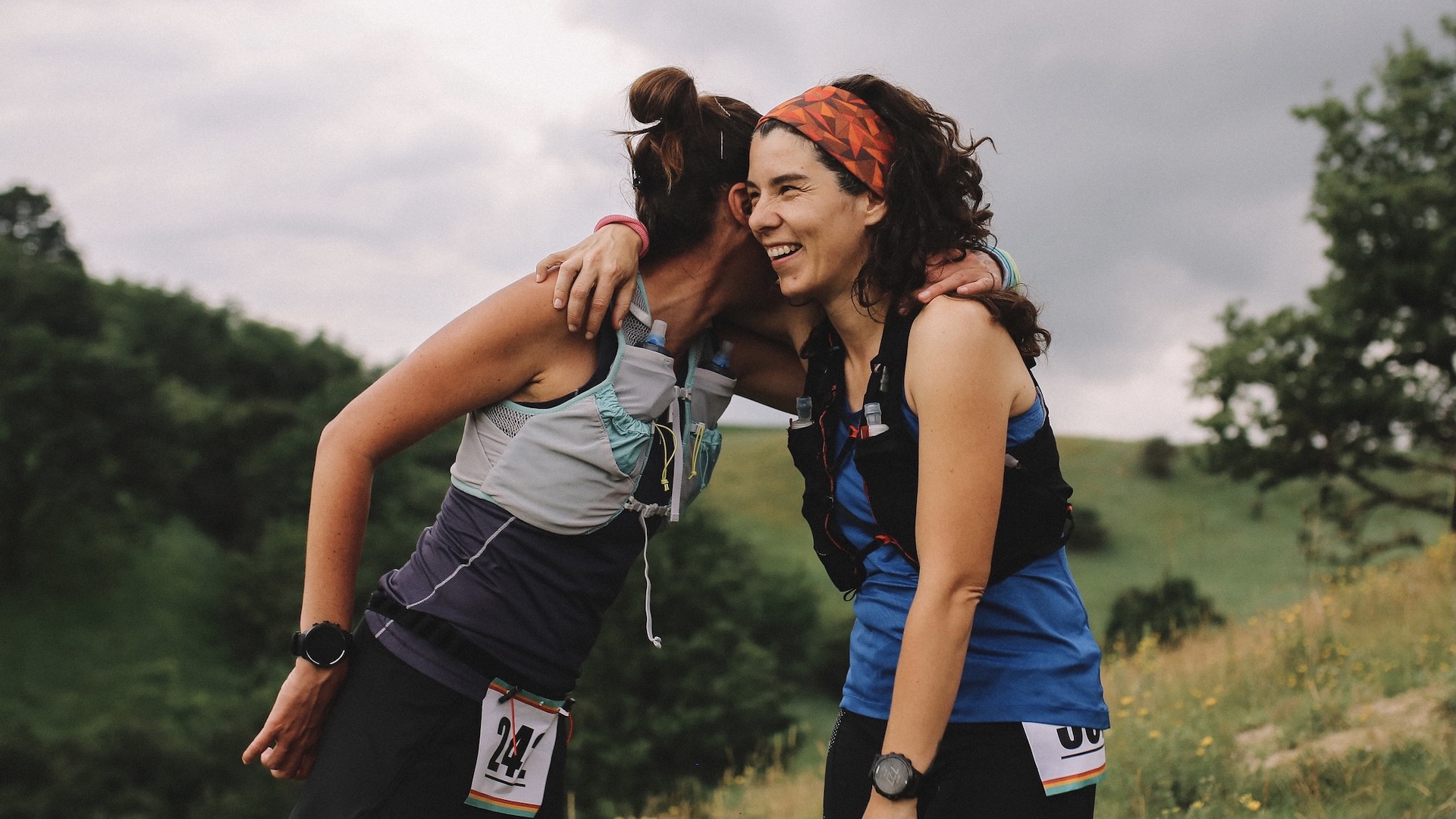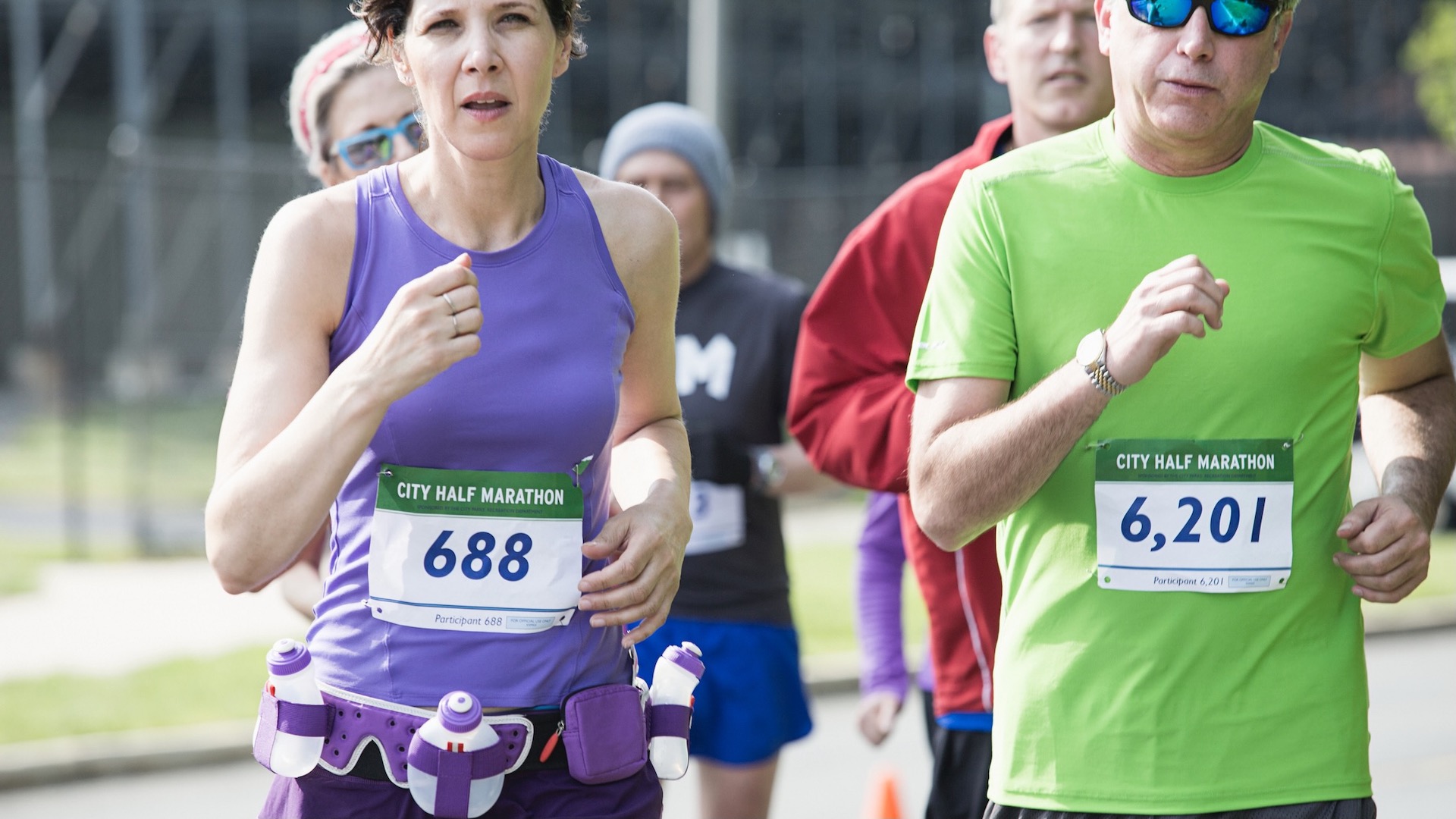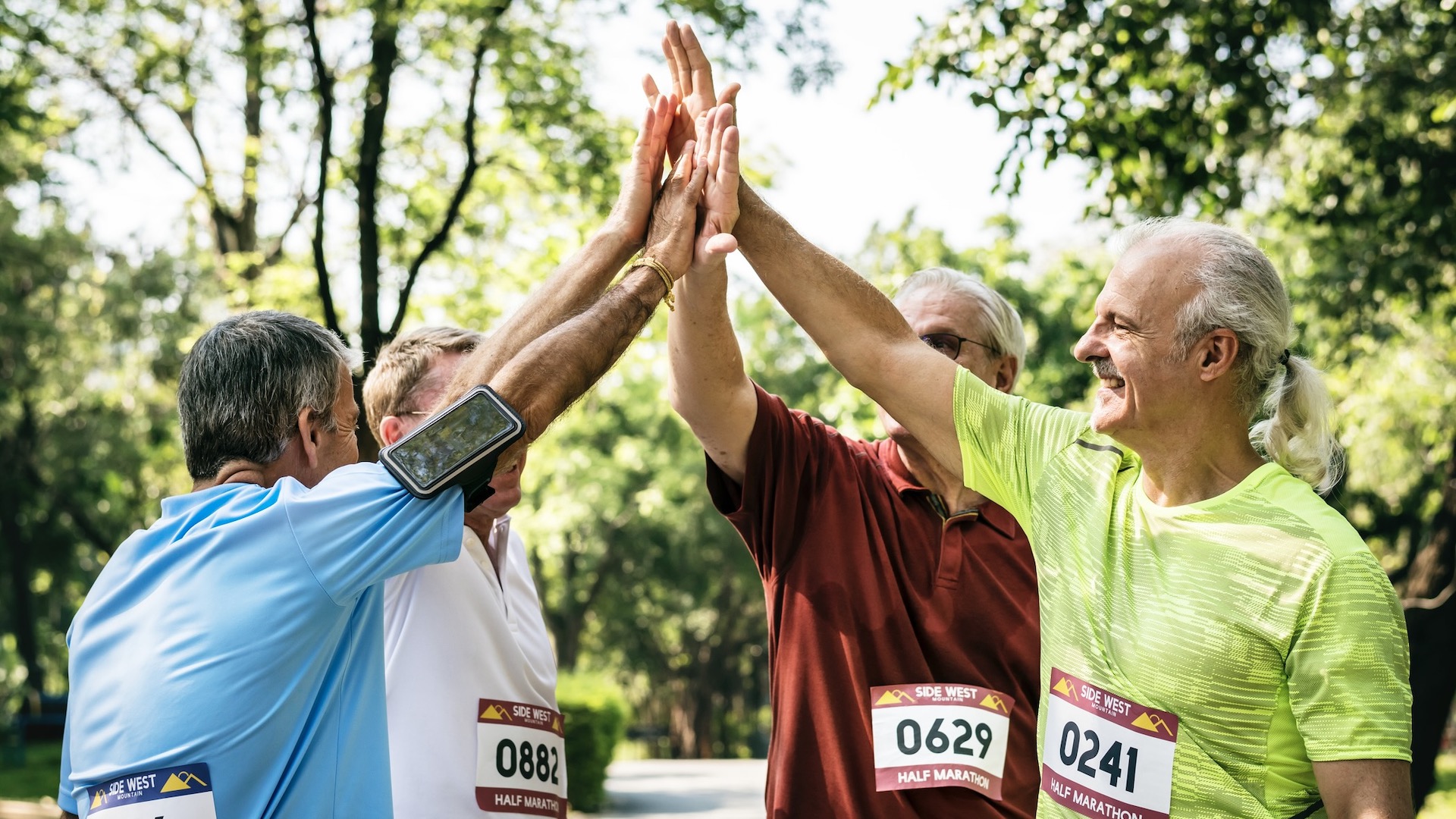Half marathon training plan for all levels of runners
An in-depth expert guide to running 13.1 miles, including a half marathon training plan, nutrition tips and more

Are you looking for a new running goal? A half-marathon is a great target for many runners, especially if you have already completed a 5k and a 10k race. We asked two experienced runners for their tips for a half marathon training plan.
A half marathon is an official distance 13.1 miles or 21.09km and there are races and events that take place on road and trail across the UK and worldwide.
Perhaps you already have a half-marathon race or challenge in the diary and you are looking for an expert half marathon training plan, or maybe you are keen to start following a training schedule before running the distance for the first time. Wherever you are at in your bid to complete a half marathon, our experts will give you all the tips and advice required for success.
Why train for a half marathon?
Christian Allen, a qualified Leader in Running Fitness (LiFR) with England Athletics, believes that a half marathon is a fantastic distance to train for.
He says: “Not only is it a brilliant achievement to complete a half marathon as a runner, but it is a good way to enter the world of longer distance running and push your body to see what it is capable of.
“A half marathon is also an ideal distance because while it is a challenge, and does require the need to train and follow a training plan, it isn’t too overwhelming.”
Jack Kelly, a keen runner who is also an LiFR and has won several half marathon races, agrees. He says: “A half marathon is the perfect distance to train for as a runner. I love a marathon, but the toll it takes on your body is more difficult to manage.
All the latest inspiration, tips and guides to help you plan your next Advnture!
"With a half marathon, you’re pushing your body to a challenging distance, but not far enough to cause major damages, when taking into account preparation, rest and recovery, and nutrition.
“When you go beyond 16-ish miles, your body can start to struggle, which means posture and form can be affected. That’s why I think a half marathon is a great distance to push yourself towards and, hopefully, remain injury-free.”

Who is a half marathon race for?
Christian, who is also a product trainer at Runners Need, believes that almost all runners can train and run a half-marathon event. He adds: “It is particularly great for runners who may have already been taking part in 10k races and who want to challenge themselves further.”
Meanwhile, Jack points out that while expectation and performance will vary from runner to runner, with a good half marathon training plan many people can complete this race distance, from newcomers to elite runners.
He adds: “If you are looking for a challenge as a novice runner, it’s a nice distance to aim for. Any distance is a great achievement, but for buzz, atmosphere and achievement I think a half marathon suits most people because it’s long enough to really test you, but also not so far as to cause any major damage.
“From a higher level perspective, I personally find it my favourite race. It’s fun to train for because you don’t really have to ever go beyond 13 miles in training which means your body isn’t getting punished like a marathon. It’s also less intense than a 5k or 10k, which means training is a bit more fun because you get the enjoyment of long and slow runs.”

Runner tips: How long to train for a half marathon?
A half marathon training schedule will vary from person to person and depending on a runner’s base level of fitness and experience. However, most half marathon training plans tends to be around 10 to 12 weeks, with the last week or two dedicated to tapering ahead of the race.
Jack also recommends a 12-week training plan. He advises that runners look for a half marathon training programs that include three key runs each week, short and fast; intervals/hill reps; and longer and slower runs.
He says: “With 12 weeks, you get the chance to build up your base fitness, and also add in speed running sessions.
“This means there is time to build up endurance and speed without pushing your body overly hard and, hopefully, by race day you will be ready to put in a good effort.”

Why a half marathon training program is vital to avoid injury
The most important piece of advice from the experts is to use a half marathon training plan that gives you plenty of time to prepare for the race – and don’t rush your training too hard.
Christian says: “If you try to build up too quickly, you risk suffering an injury, which could set you back weeks. It is also important not to go too hard too soon and to make sure you’re listening to your body and giving it some rest to recover as well.
“A training plan suited to your ability level and fitness will be the key to training with less potential for injury.”
He is also an advocate of a good warm up plan and also cooling down after a training run if runners hope to avoid injury.
Christian adds: “Strength training is another vital part of any runner’s half marathon training schedule. Not only will it help improve form but it will also help in preventing injury, too.
“At least one session a week as part of a half marathon training schedule is usually a good guide and runners should concentrate on exercises that target all the little muscles in their feet, as well as ankles, shins, hamstrings, quads and glutes.
“It is also worth putting some focus on strengthening your core to keep you upright, as well as your arms, which can help drive you forward with each stride.”
Jack takes his training plans seriously and aims to do five minutes of Pilates type exercises before every run. He says: “Taking care of your body is key to avoiding injury. This includes various leg stretches and strengthening, but it only takes me about five minutes. If you put that five minutes in before you run, then you’re loosening your joints and getting yourself prepared.
“Warm ups and cool downs are also key, even as simple as a brisk walk, high knees and arm circles, can really help.”
In addition, Jack believes cross training is a useful way to avoid injuries sustained through the repetitive motion of running. He says: “Other forms of exercise such as swimming can give a good balance for runners.”
A good half marathon training plan should also include the right level of running recovery so your body can reap the benefits of training and become stronger.
How to prepare for half marathon – and avoid boredom
Are you the sort of person who quickly tires of the perceived constraints of a half marathon training schedule, or you find yourself bored with the same type of running?
If so, you should follow these tips to stay on track towards your goal. Both Christian and John advocate doing a mix of training sessions.
Christian says: “In an average week of half marathon training, you should incorporate a strength session and a mixture of tempo, intervals and hill runs, as well as those steady runs that helps with mileage.
“You can also incorporate something like yoga into your training, too, to help stretch out your muscles."
Jack adds: “I like to mix it up with my training, such as doing intervals, hill reps, parkruns, running clubs and running with a friend. I like running on my own and I don’t like headphones or music when I am training, but if I vary my running I never get bored.
“And sometimes it is tough to motivate yourself, but you’ll always feel better when you’re finished than if you never did it.”
Other ideas for avoiding combatting a lack of motivation is to vary the routes that you use for half marathon training. “Switching between different running routes means you will avoid seeing the same things all the time, and it helps keeps you interested in your running,” recommends Christian.
In addition, Jack believes we need to think about why we are running in the first place. He says: "Think about why you are running. Is it for better health, a challenge or raising money? I run in memory of my dad and that keeps me going.
“Before I started running I also wasn’t very healthy, so now I appreciate everything I have turned around. I met an amazing person, who is now my wife and mother to my child, and I remember what my life was before, and that keeps me going when it gets tough."
How to prepare for half marathon – and run a faster time
The way to run a faster half marathon is to aim to train at a faster pace. But it’s important to listen to the experts and make sure you get the right advice about building up your pace safety and to avoid injuries.
Christian said: “Speed sessions are essential if you’re looking to run faster. Hill runs and interval runs can help with this as can increasing the duration of your tempo runs, too.”
Jack follows an 80/20 rule – 80% at a steadier pace and 20% at a faster pace – for his half marathon training. His half marathon time started at around 1 hour 50 minutes and his time is now sub 1:10.
He has won three half marathons in the last year, came second in the Leeds Half Marathon and the Ilkley Half Marathon, plus he was third in the York Half Marathon.
He says: “If you simply run at one pace and don’t do enough runs in a week, then you won’t speed up.
“I have achieved faster times by adding shorter speed work to my longer runs. My hardest runs in a week are often the shortest because they are more intense.”

Half marathon training plan: trail or tarmac
A tarmac-based half marathon is likely to provide a faster time, while a trail race is likely to be harder underfoot, especially if it’s muddy or rocky, and so you should adjust your expectations of your finish time.
If you plan to run a half marathon on the trail or the tarmac, it’s important to include similar terrain in your half marathon race plan. You should also ensure you are wearing the right running footwear – for example, the best trail running shoes – for your chosen goal.
Jack says: “I prefer tarmac half marathons because I love the speed.”
How to train for a flat or hilly half marathon race
While there are obviously differences between a flat or hilly marathon race, the principles of the half marathon training plan are the same. Jack says: “Whatever kind of route you are running, you still get a lot of benefits from doing hills and flat.
“I prefer flatter races as there’s more chance of a PB, but I’ve got quicker at racing because of the hills that I train on. No race is ever the same, but for training I’d always recommend mixing up hills and flat regardless of the race course.
“Hills are also great for strengthening your muscles and you will find a lot of benefits when racing flat courses.
“Flat training is great for working out your overall pace and averages and it also offers an opportunity to run your fastest ever PB.
“But it’s all about preference as some people love the hills and some people love the flat. I think people should focus on whatever will keep them interested in running.”

Half marathon training program: the right nutrition
Owen Woodley is a performance nutritionist at Nutrition X. He reports that there are many nutritional considerations that distance runners will have to acknowledge when training for a half marathon, including dehydration, over-hydration, running out of energy, overheating, cramping and gastrointestinal upsets, to name a few.
For fuelling training runs, carbohydrates will be the primary fuel source. Owen says: “During distance events, due to the intensity and duration, carbohydrate is the main source of energy for fuelling the body.
“However, the body will need different amounts of carbohydrate depending on the aim of the training run. Generally, the longer and harder the run, the more carbohydrates you will need.
“Based on this, you will then work your nutrition around your half marathon training schedule. For example, if you plan to run a long distance on a Saturday, then carbohydrate intake should be increased on the Friday to allow enough fuel to be stored in the body.
“This method of nutrition practice is based on fuelling for the work required, where you change your food intake day to day depending on the physical demands of that day or session."
Owen advises that training runs should be used to practise race nutrition. He says: “Training is the time to test race fuelling if you want to avoid any gut upsets and this will allow you utilise the fuel better.
“For the longer runs, you can start to load with carbohydrates the day before with foods such as pasta, rice, potatoes, porridge, fruits and smoothies. Then, fuel the run on the day with a high carbohydrate breakfast such as porridge with banana or dried fruit and honey, bagels with peanut butter, eggs on toast and fruit juice or a fruit smoothie.
“During the run, you can start to introduce simple carbohydrate foods as you cover the miles to help keep you topped up and avoid running out of energy.”
Owen’s guidance for running times is as follows:
45 to 75 mins: 0-20g/h
1hr to 2.5hr: 30-60g/h
> 2.5hr: Up to 90 g/h.
Half marathon nutrition plan: the day before the race
Fatigue during prolonged exercise is often associated with muscle glycogen depletion and reduced blood glucose concentrations, via inadequate carbohydrate intake.
Nutritionist Owen says: “Carbohydrates can deliver energy much faster to the muscles than fats but they have a much smaller storage capacity and so can deplete during prolonged events.
“Using your carbohydrate loading strategy from your training runs in the days before the event can help to maximise the carbohydrates that are stored in the muscle and liver to fuel the event. Hydration is also important to maintain during this time.”
Half marathon nutrition plan: the morning of the race
Owen reports that for the best half marathon plan fuelling, the majority of carbohydrates should have already been consumed in the days prior to the race.
He adds: “The pre-race meal should be around two to three hours before the event and should simply be a top up of carbohydrates to ensure the tank is full before you start.”
Half marathon nutrition plan: during the race
It’s important that you do not try anything new foods and snacks on race day. Owen says: “Stick to the products that you know and are comfortable with and simply replicate the strategy you have built from your training.”

Half marathon training programs for different levels of fitness
Jack believes that whatever your level of running fitness there are three key sessions to include in a training plan.
He says: “The best half marathon training plans include a short/medium length running session with a medium effort.
“There should also be hill reps pr intervals with a high intensity efforts. Plus you should see a slower, longer run at a steadier pace in the mix of the training."
Jack continues that for beginners to a half marathon training plan, the longer run can be a mix of running, jogging and walking. Meanwhile, for more experienced runners, you should aim to push harder on the longer run sessions.
Jack says: “I run around six sessions a week now, but I still base my training on completing three key runs a week, while the other three runs I do are about getting the mileage on my legs with recovery runs, easy effort runs and more.
“If you’re in the middle, between beginner and more expert, you should complete the three key runs a week and then try to add a fourth run in.”
Extra tips for your half marathon training plan
As well as the running training, there are other factors to consider when preparing for a half marathon. For example, in the week leading up to your race, it is important to remain calm.
Christian says: “Remember that you’ve done all the hard work during your training and squeezing in extra off-plan runs won’t help.
“You should mentally go through the course and work out where any aid stations are on the route, so you can plan for how much water and fuel you may need to take with you.
“It is also a good idea to plan how you are going to get to the event in plenty of time to avoid any last-minute stresses.
“And one of my biggest tips is to make sure that you’ve run in the kit you’ll be wearing on the day so that you know they are comfortable.”
On half marathon race day it is important that you do not try anything new. Christian adds: “Don’t do anything differently or try anything new on race day, especially when it comes to fuelling as you don’t know how your body will react.
“Turn up early and make sure that you visit the toilet before the start of the race. Pre-race nerves are common for many runners, regardless of experience.”
Another tip that Christian suggests is writing your name on your race number or running top so that when spectators see it they will give you a name check and a cheer. He says: “This can really help to give you a push when you hear encouragement from the crowds around the course.”
Jack has some further tips to add. His advice is to make sure you get the right running shoes by going to a running shop and getting a professional to help.
He adds: "Practise your race day run before the event with less intensity and mileage, including what you are going to wear, eat and drink etc before and during the half marathon.
"Read blogs and look out for people on social media who have experience.
"And never give up unless you’re injured. If you need to walk parts, then walk, but you should always aim to enjoy the race."
What to wear for a half marathon
The aim is to achieve the right body temperature and this will depend on the time of year that you are running your half marathon.
Think about layering with several thinner layers, rather than one thicker layer. Choose layers that allow the sweat to wick away, too.
A running jacket or gilet will be a good idea if the weather looks like being wet, cold or breezy. Once you warm up, you can take off the jacket and add to a pocket or a small hydration pack.
Choose shorts or skort, running leggings or tights or whatever you know will be comfortable and keep you at just the right temperature for the conditions.
Your choice of running shoes will depend on whether it is a tarmac, trail or a mix of both for the chosen half marathon.
Also consider taking a hydration pack if you want to rely on your own fluids and snacks.
Accessories for a half marathon might include sunglasses, hat, gloves and you will probably want one of the best GPS watches to time your race, as well as a mobile phone.
Christian adds: “Before the race there is often a bit of waiting around on the start line and you could become cold, so wearing something with a zip that is easy to take off is ideal.
“Some races also collect unwanted clothing to give to charity, so if you don’t fancy carrying that layer with you, opt for something old that you don’t mind getting rid of.”

A half marathon training plan in action
Experienced runner Christian offer some words of wisdom on how to run the half marathon. He says: “It’s very easy to get carried away with the emotion of the day and be impacted by the other runners around you but it is so important that you stick to how you’ve been training.
“One of the most common mistakes people make is starting off too quickly. If you do begin to struggle, use things around you to help you to keep going. You could even try buddying up with another runner to chat to.
“The great thing about these events is that there are usually lots of pace makers, so try to stick to your group and try not to lose them, or you can dig deep and remember why you signed up to take part in the race and picture yourself at the finish line.
“Most importantly however, is to enjoy yourself and soak up the atmosphere.”

Fiona Russell is a widely published adventure journalist and blogger, better known as Fiona Outdoors. She is based in Scotland and is an all-round outdoors enthusiast with favorite activities including trail running, mountain walking, mountain biking, road cycling, triathlon and skiing (both downhill and backcountry). Aside from her own adventures, Fiona's biggest aim is to inspire others to enjoy getting outside and exploring, especially through her writing. She is also rarely seen without a running skort! Find out more at Fiona Outdoors.
